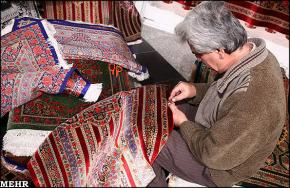ID :
95824
Sat, 12/19/2009 - 15:10
Auther :
Shortlink :
https://oananews.org//node/95824
The shortlink copeid
Iran seeking registration of Fars carpet art on UNESCO list

TEHRAN, Dec. 19 (MNA) -- Iran has recently submitted documents for registering the art of carpet weaving as uniquely practiced in the Fars region on UNESCO’s List of the Intangible Cultural Heritage of Humanity.
The documents comprise 120 photographs illustrating various processes of the art common mostly among the nomads of southern Iran, the Fars Cultural Heritage, Tourism and Handicrafts Department said in a press release on Thursday.
The collection of documents also contains a ten-minute film featuring shearing, wool spinning, dyeing and carpet weaving by the nomads, and several books on the art.
The documents, along with several items are scheduled for discussion during a meeting to be hosted by the UNESCO World Heritage Center at UNESCO Headquarters on January 20, 2010.
The indubitable history of Fars carpet weaving began in the early eighth century CE, when carpets along with gold and silver were accepted as currency in the tax system of the Islamic caliphs ruling Iran.
The art flourished in the late 13th century CE so that Ghazan Khan, the most prominent of the Ilkhanids of the Mongol dynasty to rule in Iran, ordered Fars artisans to weave carpets for his place in Tabriz.
However, many experts believe that the art dates back to the Achaemenid period in five centuries BC.
Designs of Persian horsemen with Achaemenid weapons and costumes are the most common patterns used in this style of carpet weaving.
The documents comprise 120 photographs illustrating various processes of the art common mostly among the nomads of southern Iran, the Fars Cultural Heritage, Tourism and Handicrafts Department said in a press release on Thursday.
The collection of documents also contains a ten-minute film featuring shearing, wool spinning, dyeing and carpet weaving by the nomads, and several books on the art.
The documents, along with several items are scheduled for discussion during a meeting to be hosted by the UNESCO World Heritage Center at UNESCO Headquarters on January 20, 2010.
The indubitable history of Fars carpet weaving began in the early eighth century CE, when carpets along with gold and silver were accepted as currency in the tax system of the Islamic caliphs ruling Iran.
The art flourished in the late 13th century CE so that Ghazan Khan, the most prominent of the Ilkhanids of the Mongol dynasty to rule in Iran, ordered Fars artisans to weave carpets for his place in Tabriz.
However, many experts believe that the art dates back to the Achaemenid period in five centuries BC.
Designs of Persian horsemen with Achaemenid weapons and costumes are the most common patterns used in this style of carpet weaving.





